
A couple of weeks ago I wrote this post explaining why I do not believe that "Bike Month" is effective at making transportation cycling accessible to non-cyclists and beginners. In the discussion that followed, many different opinions were expressed - which I appreciate. In addition, a couple of readers suggested that, since I criticised the approach, perhaps I could follow up with my own ideas. If not bike month, then what alternative would I propose? That was a good point, and I have now prepared my response. This is far from the first time I've considered the issue. But it's one thing to have my head full of ideas, and quite another to express them lucidly. Let me give it a try.
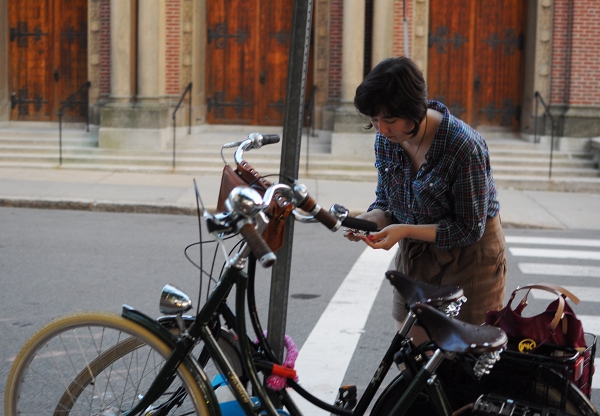 A Support System for Cyclists
A Support System for CyclistsIf the goal of a city, community, or organisation is to make cycling an accessible form of transportation, I propose a year-round support system permanently in place. This support system could exist in the form of a small department within the local government structure, or in the form of an independently funded non-government organisation. The sole mission of this department or organisation would be to provide a range of services - in the form of literature, materials, counseling, classes and workshops, and more - to persons interested in transportation cycling. It is crucial that the office or organisation providing these services be non-partisan - which includes independence from political groups, environmental organisations, or any other entities with specific agendas to pursue. The goal of this office or organisation would not be to
promote cycling, but to
support cyclists or those considering cycling - which is a crucial distinction. Trained employees would work with person, families, and groups to determine their level of comfort, their concerns and their goals - responding appropriately and providing them with relevant resources. The existence of this office or organisation would be made known to the public via an online presence, via brochures available at relevant local venus, and via announcements in the local media.
While I have quite detailed and concrete ideas of how this fictional entity would function, outlining all of them would require its own post - or more like a multi-page proposal. But I think you get the gist of what I envision. Having a solid, well-developed support system in the community that any cyclist can rely on is, would in my view, be more effective than a month-long annual event that is dense in activities while it lasts, only to end abruptly. A year-round support system would also send the message to the community that cycling is an accepted and attainable means of transportation.
 A "How, Not Why" Approach
A "How, Not Why" ApproachIt is my belief that the chances of non-cyclists finding the idea of transportation cycling appealing are diminished, rather than improved by the "hard sell" tactics employed by the majority of bicycle activists (and by the very notion of bicycle activism, for that matter). When people try too hard to convince us that something is "good for us" or morally superior, our natural response is to be skeptical, to resist. After all - if it's so wonderful, then why are they trying so hard to persuade us and why isn't everyone already doing it? For this reason, I think it is misguided to "sell" cycling. Moreover, cycling doesn't
need to be sold: It is a trend on the rise, particularly in large cities that are centers of popular culture. People everywhere are already enjoying riding their bicycle for transportation, and we need merely to communicate this fact as a given. Instead of telling people
why they should cycle, make it an implicit assumption that they already want to do it (of course! doesn't everyone?) and focus on the
how. I believe that this approach must underlie any initiative or outreach program designed to encourage new cyclists.
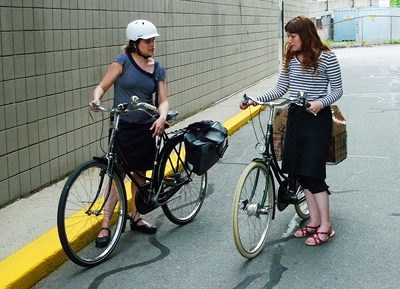 Ideas for a How-To Brochure
Ideas for a How-To BrochureOne thing discussed with particular zeal in the comments of my post about bike month, was the Bike to Work Week commuter booklet - a transportation cycling guide offered as promotional literature by the organisers of Bike Month. Here I described the ways in which nearly every page of the brochure portrays transportation cycling as a challenging and possibly dangerous athletic activity, which I believe makes the brochure intimidating rather than inviting. In response, I will outline my vision for an alternative brochure.
Title:"A Guide to Cycling for Transportation"
Introduction:Start by mentioning that cycling for transportation is becoming increasingly popular, and many people are wondering how to go about starting. This brochure is for them.
How to begin:Explain how easy it is to commute by bicycle, dispelling myths that athleticism, energy bars, or special cycling clothing are necessary in order to commute to work on a bike.
Choosing a bicycle:Inform of the existence of comfortable transportation bicycles, and explain which accessories are necessary in order to commute in work clothing. List bicycle shops that specialise in commuter bicycles and perhaps websites that focus on reviewing them.
Road rules:Using clear and simple language, outline the basic cycling laws in your area, providing link to full version.
Safety:Be objective and positive. Cite statistics that reveal bicycling to be a relatively safe activity. Stress the necessity of good brakes, proper lighting, and adherence to road rules first and foremost. Explain that opinions on helmets are mixed, and while some choose to wear them, others do not.
Illustrations:Choose appealing images where persons are shown cycling at a relaxed pace while wearing street clothing and riding transportation bicycles with appropriate accessories. Include signs of normal, everyday activities: parents transporting children, persons in suits cycling with briefcases strapped to rear racks, grocery panniers with flowers sticking out, and so on. Images should communicate that cycling is easy, convenient and pleasant. Helmet use can be portrayed in a manner that represents freedom of choice: Some cyclists can be shown wearing one and other cyclists not, in a way that both come across as natural (see image above, or this image from a recent bike advert).
Further Resources:
Provide a list of popular websites focusing on transportation cycling.
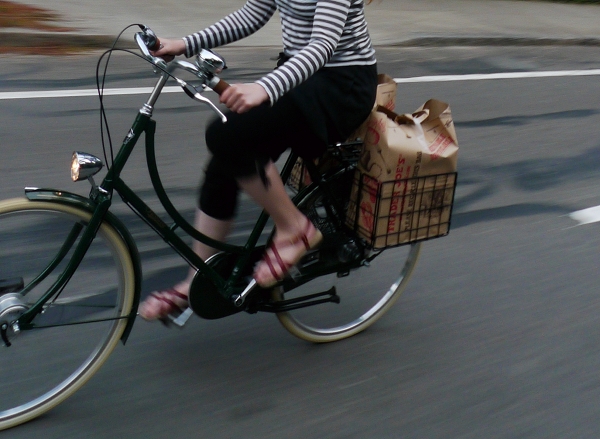
Given that small, specific things are easier to implement than grandiose plans, I think that creating a brochure such as the one I outlined to counteract the one promoted via Bike Month would in itself be useful to those who are considering cycling for transportation and do not know where to begin. But making one - as well as thinking up the means of distributing it - is a project that would require hours of my time and is beyond the scope of this blog. Putting forth ideas is far more difficult than merely criticising, and I am exhausted from writing this post. Your thoughts on all of this are, of course, welcome.














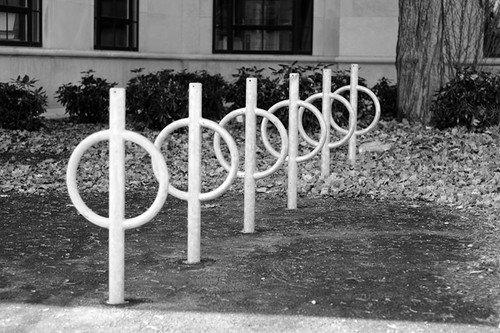 Although there are plenty of complaints about the lack of bicycle parkinghere, my impression is that the greater Boston area is better than many places in this respect. There are bicycle racks all over shopping districts, outside post offices, libraries and prominent places of business, next to transit stations, throughout college campuses. But I notice that cyclists do not always choose to use the racks, preferring to lock their bicycles to alternative structures instead. There will sometimes be a rack that is almost entirely empty, and nearby there will be some bicycles locked to trees and sign poles.
Although there are plenty of complaints about the lack of bicycle parkinghere, my impression is that the greater Boston area is better than many places in this respect. There are bicycle racks all over shopping districts, outside post offices, libraries and prominent places of business, next to transit stations, throughout college campuses. But I notice that cyclists do not always choose to use the racks, preferring to lock their bicycles to alternative structures instead. There will sometimes be a rack that is almost entirely empty, and nearby there will be some bicycles locked to trees and sign poles. The other day I saw a group of cyclists locking up their bikes outside a cafe - each one of them ignoring the racks and going for random other structures. I commented about it, and we had an interesting conversation. Here are some of the reasons they gave for not using the racks provided:
The other day I saw a group of cyclists locking up their bikes outside a cafe - each one of them ignoring the racks and going for random other structures. I commented about it, and we had an interesting conversation. Here are some of the reasons they gave for not using the racks provided: Great Sand Dunes National Park & Preserve
Great Sand Dunes National Park & Preserve Dave on one of the ramps of the Desmaison/Gouseault on the Grandes Jorasses
Dave on one of the ramps of the Desmaison/Gouseault on the Grandes Jorasses Just call me Lefty :)
Just call me Lefty :) many metersof ice
many metersof ice 


 A couple of weeks ago I wrote this post explaining why I do not believe that "Bike Month" is effective at making transportation cycling accessible to non-cyclists and beginners. In the discussion that followed, many different opinions were expressed - which I appreciate. In addition, a couple of readers suggested that, since I criticised the approach, perhaps I could follow up with my own ideas. If not bike month, then what alternative would I propose? That was a good point, and I have now prepared my response. This is far from the first time I've considered the issue. But it's one thing to have my head full of ideas, and quite another to express them lucidly. Let me give it a try.
A couple of weeks ago I wrote this post explaining why I do not believe that "Bike Month" is effective at making transportation cycling accessible to non-cyclists and beginners. In the discussion that followed, many different opinions were expressed - which I appreciate. In addition, a couple of readers suggested that, since I criticised the approach, perhaps I could follow up with my own ideas. If not bike month, then what alternative would I propose? That was a good point, and I have now prepared my response. This is far from the first time I've considered the issue. But it's one thing to have my head full of ideas, and quite another to express them lucidly. Let me give it a try. A Support System for CyclistsIf the goal of a city, community, or organisation is to make cycling an accessible form of transportation, I propose a year-round support system permanently in place. This support system could exist in the form of a small department within the local government structure, or in the form of an independently funded non-government organisation. The sole mission of this department or organisation would be to provide a range of services - in the form of literature, materials, counseling, classes and workshops, and more - to persons interested in transportation cycling. It is crucial that the office or organisation providing these services be non-partisan - which includes independence from political groups, environmental organisations, or any other entities with specific agendas to pursue. The goal of this office or organisation would not be to promote cycling, but to support cyclists or those considering cycling - which is a crucial distinction. Trained employees would work with person, families, and groups to determine their level of comfort, their concerns and their goals - responding appropriately and providing them with relevant resources. The existence of this office or organisation would be made known to the public via an online presence, via brochures available at relevant local venus, and via announcements in the local media.
A Support System for CyclistsIf the goal of a city, community, or organisation is to make cycling an accessible form of transportation, I propose a year-round support system permanently in place. This support system could exist in the form of a small department within the local government structure, or in the form of an independently funded non-government organisation. The sole mission of this department or organisation would be to provide a range of services - in the form of literature, materials, counseling, classes and workshops, and more - to persons interested in transportation cycling. It is crucial that the office or organisation providing these services be non-partisan - which includes independence from political groups, environmental organisations, or any other entities with specific agendas to pursue. The goal of this office or organisation would not be to promote cycling, but to support cyclists or those considering cycling - which is a crucial distinction. Trained employees would work with person, families, and groups to determine their level of comfort, their concerns and their goals - responding appropriately and providing them with relevant resources. The existence of this office or organisation would be made known to the public via an online presence, via brochures available at relevant local venus, and via announcements in the local media. A "How, Not Why" Approach
A "How, Not Why" Approach Ideas for a How-To Brochure
Ideas for a How-To Brochure Given that small, specific things are easier to implement than grandiose plans, I think that creating a brochure such as the one I outlined to counteract the one promoted via Bike Month would in itself be useful to those who are considering cycling for transportation and do not know where to begin. But making one - as well as thinking up the means of distributing it - is a project that would require hours of my time and is beyond the scope of this blog. Putting forth ideas is far more difficult than merely criticising, and I am exhausted from writing this post. Your thoughts on all of this are, of course, welcome.
Given that small, specific things are easier to implement than grandiose plans, I think that creating a brochure such as the one I outlined to counteract the one promoted via Bike Month would in itself be useful to those who are considering cycling for transportation and do not know where to begin. But making one - as well as thinking up the means of distributing it - is a project that would require hours of my time and is beyond the scope of this blog. Putting forth ideas is far more difficult than merely criticising, and I am exhausted from writing this post. Your thoughts on all of this are, of course, welcome.
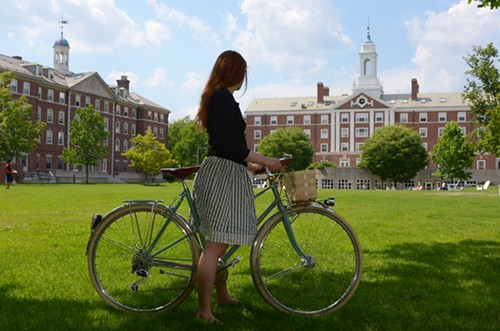 Lately I've been testing and experimenting with many bikes, and some have asked which ones I ride on a regular basis. Or do I ride a different one every day? Well, definitely not that. Despite a penchant for accumulating temporary and permanent bicycles, I prefer to ride the same ones over and over, and the fewer the better. The rotation changes, but the pattern has been three bikes at a time. Now that it's the hottest part of the summer, I've been riding the mixte for transportation, as well as a roadbike and a touring bike for sporty rides. As the cold season approaches I will start riding the mixte less and my hardy 3-speeds more. For roadcycling I will probably switch to a fixed gear as the days grow shorter, because it packs more punch into shorter rides. But all in all, it's pretty much no more than three bikes at a time for me, one of which is always a fully equipped transportation bike.
Lately I've been testing and experimenting with many bikes, and some have asked which ones I ride on a regular basis. Or do I ride a different one every day? Well, definitely not that. Despite a penchant for accumulating temporary and permanent bicycles, I prefer to ride the same ones over and over, and the fewer the better. The rotation changes, but the pattern has been three bikes at a time. Now that it's the hottest part of the summer, I've been riding the mixte for transportation, as well as a roadbike and a touring bike for sporty rides. As the cold season approaches I will start riding the mixte less and my hardy 3-speeds more. For roadcycling I will probably switch to a fixed gear as the days grow shorter, because it packs more punch into shorter rides. But all in all, it's pretty much no more than three bikes at a time for me, one of which is always a fully equipped transportation bike. Mendenhall Glacier as seen from the rear of my campsite at Mendenhall Lake campground in the Tongass National Forest. The full face of the glacier cannot be seen from this vantage point because it is blocked by the bit of land jutting out from the left.
Mendenhall Glacier as seen from the rear of my campsite at Mendenhall Lake campground in the Tongass National Forest. The full face of the glacier cannot be seen from this vantage point because it is blocked by the bit of land jutting out from the left. The view from the Visitors Center. We are seeing only a very small portion of the glacier as it extends 12 miles back down the valley.
The view from the Visitors Center. We are seeing only a very small portion of the glacier as it extends 12 miles back down the valley. A little bit closer.
A little bit closer. An awesome waterfall flows down from above. Another waterfall can be seen in the far distance to the right of the glacier.
An awesome waterfall flows down from above. Another waterfall can be seen in the far distance to the right of the glacier. A ride on the lake gets you a little closer to the face of the glacier.
A ride on the lake gets you a little closer to the face of the glacier. Some of the larger icebergs floating in Mendenhall Lake. Icebergs are created when the glacier calves (chunks of ice fall off the face of the glacier).
Some of the larger icebergs floating in Mendenhall Lake. Icebergs are created when the glacier calves (chunks of ice fall off the face of the glacier). I couldn't resist picking up a chunk of glacial ice that was floating close to the shore. It was crystal clear and many, many years old. And it was cold...
I couldn't resist picking up a chunk of glacial ice that was floating close to the shore. It was crystal clear and many, many years old. And it was cold...
 Summit shot (photo by Julie Labrecque)
Summit shot (photo by Julie Labrecque) This picture below, of Malissa, was taken about 1930. Am I imagining it, or is there really no resemblance?
This picture below, of Malissa, was taken about 1930. Am I imagining it, or is there really no resemblance? Back to the two seated ladies in the first picture. When I first saw this picture several years ago, I had no idea who Alla and Flora might be. But I've done some research since then ;-) and the only people in my genealogy database that "fit" in any way whatsoever (assuming the people in the picture are related) are Alice and Flora Joslin, daughters of Malissa's uncle Edwin Joslin, and thus, her first cousins. Of course, I don't know for sure, but that's who I think they are.
Back to the two seated ladies in the first picture. When I first saw this picture several years ago, I had no idea who Alla and Flora might be. But I've done some research since then ;-) and the only people in my genealogy database that "fit" in any way whatsoever (assuming the people in the picture are related) are Alice and Flora Joslin, daughters of Malissa's uncle Edwin Joslin, and thus, her first cousins. Of course, I don't know for sure, but that's who I think they are. 









